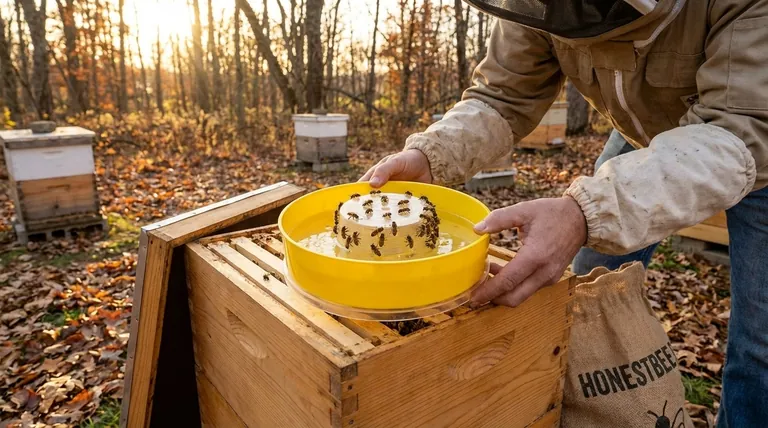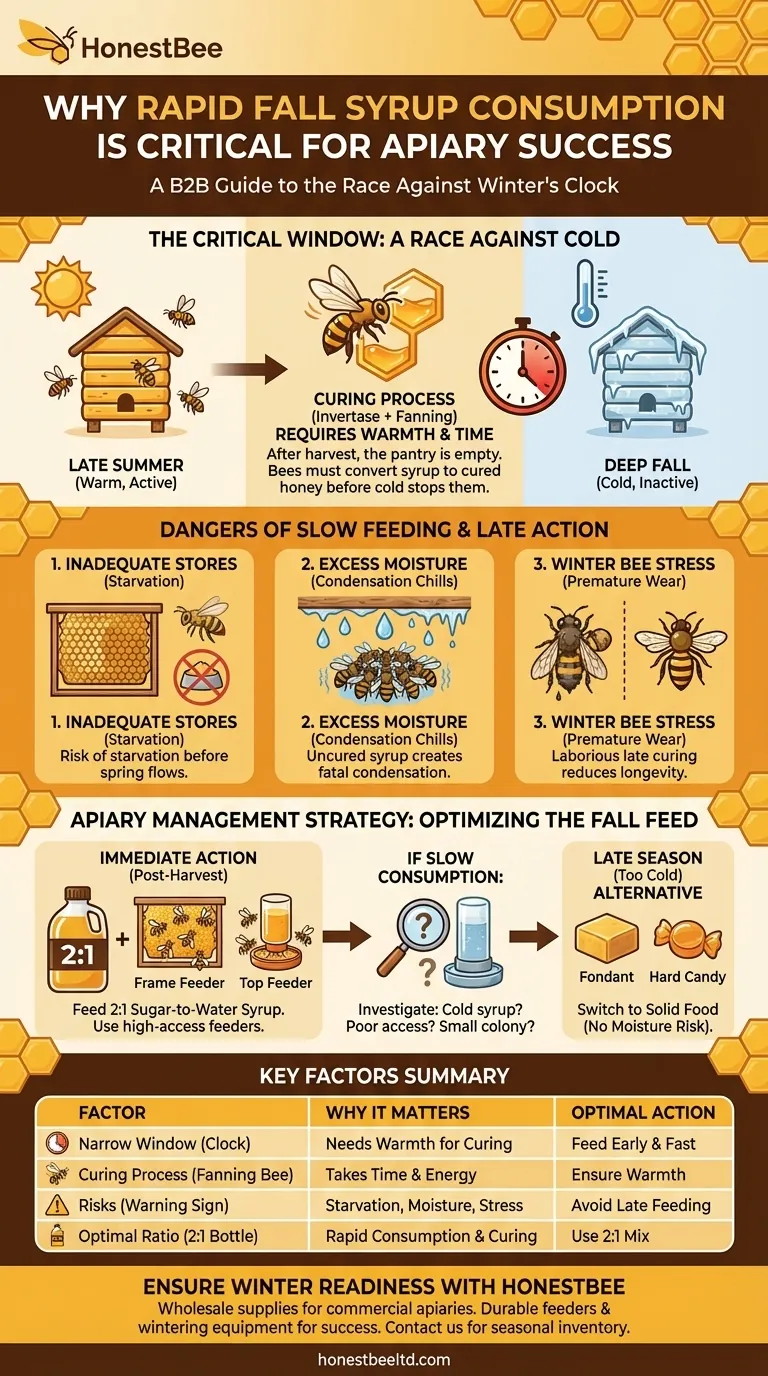To put it simply, rapid consumption of syrup in the fall is critical because there is a very narrow window of time for bees to process this food and store it for winter. Once temperatures drop, their ability to take in and cure syrup plummets, putting the entire colony at risk.
The core challenge of fall feeding is a race against the calendar. Your goal is to help the bees convert liquid syrup into cured, stored honey before the cold weather arrives and makes that process impossible.

The Critical Window for Fall Feeding
Preparing a colony for winter isn't just about providing food; it's about providing it at the right time and in the right way. The transition from late summer to deep fall brings biological and environmental changes that cannot be ignored.
Why Timing is Everything
After the final honey harvest, the hive's pantry is effectively empty of surplus stores. The beekeeper must now ensure the colony has enough resources to survive the long, cold months ahead.
This replenishment effort is governed by a strict deadline imposed by nature.
The Impact of Dropping Temperatures
As days shorten and temperatures fall, bee behavior changes dramatically. Bees become less active and are unable to fly to forage or even move efficiently within the hive.
Critically, the enzymatic and dehydration process required to turn sugar syrup into preserved "honey" requires warmth. Cold syrup is difficult for bees to consume, and a cold hive slows their metabolism, hindering their ability to process the food they do take.
The Curing Process is Not Instantaneous
Bees don't just drink syrup and store it. They must add an enzyme called invertase to break down complex sugars and then dehydrate the mixture by fanning it with their wings.
This "curing" process takes time and requires the ambient temperature to be warm enough for the bees to work and for water to evaporate. Feeding too late means the syrup may sit uncured in the cells.
The Dangers of Slow or Late Feeding
Failing to get syrup into the hive and properly stored before winter sets in has severe consequences. Understanding these risks clarifies why speed is so essential during the fall feed.
Inadequate Winter Stores
This is the most direct and fatal risk. A colony that doesn't store enough cured food will starve before the first nectar flows of spring. Slow consumption is a clear indicator that they are not building these vital reserves.
Excess Moisture in the Hive
Uncured, watery syrup is a major liability in a winter hive. As the bees cluster for warmth, their respiration already creates moisture. Adding high-moisture stores dramatically increases the risk of condensation.
This condensation can drip down onto the cluster, chilling and killing the bees. Moisture, not cold, is often the biggest killer of overwintering colonies.
Stress on the Winter Bee Population
The generation of bees raised in the fall has a different physiology; they are built to live for months, not weeks. Forcing these "winter bees" to engage in the laborious process of curing syrup late into the season wears them out prematurely.
This reduces their longevity and jeopardizes their core mission: to keep the queen warm and survive until spring to raise the next generation.
How to Apply This to Your Hive
Your management strategy should be entirely focused on helping the bees succeed in this race against time.
- If your primary focus is rapid storage: Begin feeding a 2:1 sugar-to-water syrup mix immediately after removing your honey supers. Use a feeder style, like a frame or top feeder, that allows many bees to access the syrup at once.
- If you observe slow consumption: Immediately investigate the cause. The syrup may be too cold, the feeder may be difficult for the bees to access, or the colony might be too small to manage the intake.
- If you are running late in the season: Do not feed liquid syrup. Switch to a solid food source like fondant, hard candy, or granulated sugar, which provides calories without adding dangerous moisture to the hive.
Ultimately, successful fall feeding hinges on understanding that you are working with, and against, the clock.
Summary Table:
| Key Factor | Why It Matters |
|---|---|
| Narrow Feeding Window | Bees can only process syrup into cured honey while temperatures are warm enough for activity. |
| Curing Process | Requires time, warmth, and bee activity to add enzymes and evaporate water from the syrup. |
| Risks of Late Feeding | Includes starvation, excess hive moisture, and premature wear on winter bees. |
| Optimal Syrup Ratio | A 2:1 sugar-to-water mix is ideal for rapid consumption and curing in the fall. |
Ensure your apiary is winter-ready with the right supplies.
Time is of the essence for fall feeding. HONESTBEE supplies commercial apiaries and beekeeping equipment distributors with the high-quality, wholesale-focused supplies needed for efficient and timely hive management. From durable feeders to essential wintering equipment, we provide the tools for success.
Contact our team today to discuss your wholesale needs and secure your seasonal inventory.
Visual Guide

Related Products
- HONESTBEE Round Hive Top Bee Feeder for Syrup
- Rapid Bee Feeder White Plastic 2L Round Top Feeder for 8 or 10-Frame Bee Hives
- Classic Boardman Entrance Bee Feeder Hive Front Feeding Solution
- Professional Hive Front Entrance Bee Feeder
- Boardman Entrance Bee Feeder Durable Galvanized Steel and Wood Construction for Beekeeping
People Also Ask
- How do you set up and use a top feeder for bees? A Step-by-Step Guide for Safe Feeding
- Why is a top feeder essential for bees? Ensure Colony Health and Efficiency
- What are the features of top feeders for bees? Maximize Hive Health with Safe, High-Capacity Feeding
- How do hive top feeders work? A Guide to Efficient, High-Capacity Bee Feeding
- What types of hive boxes is the round hive top feeder compatible with? Universal Fit for 8 & 10-Frame Langstroth Hives



















